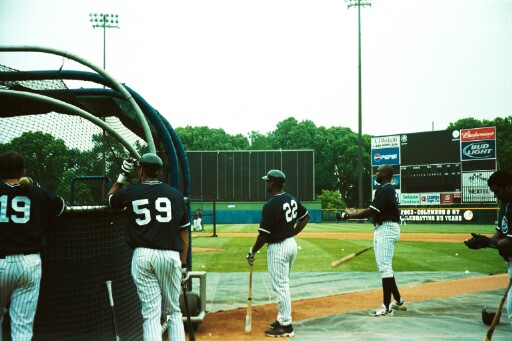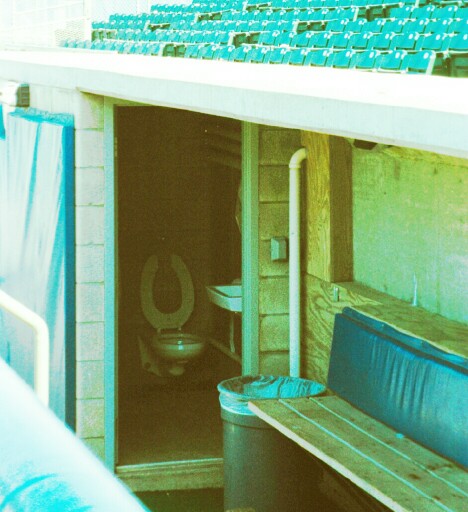 |
Triple A: One Giant Step from 'The Show'

|
| The
Clippers take BP on July 31. |
The journey from the majors to Triple A may seem, to the average fan, like a small blip in the transactions section
of yesterday's sports section; to the ball player, however, it means a complete change in lifestyle. Gone are the charter
flights, the five star hotels, and the large paychecks, instead you travel coach, stay in Super 8's, and get paid in far more
pedestrian amounts.
*************************************************************
Cooper Stadium, home of the Columbus Clippers,
the New York Yankees' Tripe A affiliate, is, according to mapquest.com, approximately 547 miles from Yankee Stadium.
To the players on each team, however, the two venues are worlds apart.
Yankee Stadium is among the hallowed grounds
in all of sports, bustling with the energy of tens of thousands of fans, a throng of media members, and scores of celebrities.
Cooper Stadium, meanwhile, is a quiet place, with no frills, a couple of thousand fans, and virtually no media members.
The closest thing to a celebrity that can be found is Clippers' 3B Drew Henson, who is most famous for playing quarterback
at Michigan.
Called by one veteran minor leaguer as "one of the worst stadiums in the (International) League," Cooper
Stadium was originally built in 1932, and has the accommodations to prove it. On the far end of the dugouts, there are
tiny bathrooms that look so uninviting, they look like a good place for a manager to put insubordinate player: "For
missing that sign in the 3rd, you get two innings in the hole!"
A pathway no higher than six feet leads from
the dugout to the clubhouse, it is damp, musty, and poorly lit. The clubhouse isn't much better. The cinder block
construction emanates the atmosphere of grandma's basement -- it doesn't take long for the players to realize that they are
a long way from the major leagues.
*************************************************************

|
| "The
Hole" |
The largest distinction between the big leagues and Triple A is the salary
structure. While veteran players that have major league experience can make near or over $100,000 annually at the Triple
A level, many younger fringe players may gross just $1,500 to $2,000 monthly. "It's a crime what they pay those guys,"
veteran Marcus Jensen said.
Several factors go into determining a veteran's pay. Players that are on the team's
40 man roster and/or have major league experience are compensated best. Minor league service time is also considered.
The pay scale also differs between organizations -- some, like the Oakland Athletics, have a set salary structure in place,
and use a "take it or leave approach" when dealing with free agents. Others, like the New York Yankees are willing to
negotiate and have a better reputation among the players.
Triple A players also spend a lot more time at Taco Bell
than do their major league counterparts. While a major leaguer's daily travel per diem for meals is roughly $70, a
minor leaguer is asked to subsist on just $21 -- ten to twelve dollars of which are used for clubhouse dues.
While
major leaguers travel first class in plush chartered jets that depart immediately after the final game of a series, Triple
Aers fly coach and usually don't depart until early the next morning. On shorter trips that range from three to
five hours, a bus is used. Many players actually prefer the bus because of the increased security at airports in the
post 9/11 world.
*************************************************************
There are several little things that remind the
players that they are still one giant step from reaching "The Show." For instance, in the major leagues, the batting
helmets have just one earflap which covers the side of the players head that is exposed while batting (the right handed hitters
covers the left ear -- switch hitters have two helmets), but in Triple A all of the helmets have two flaps.
Equipment
in general is handled differently, "In the major leagues, there is definitely a surplus of equipment, clothing -- whatever
-- and they are usually more than willing to accommodate you for whatever you need," explained 14 year pro Marcus Jensen.
"In the minors, however, they make a conscious effort to ration it, because they supposedly have a limited supply."
(Note:
Jensen did also point out that in the Yankees system, the gear seems to be more plentiful because of the organization's endorsement
contract with Adidas.)
*************************************************************
For players that have had a taste of the major
league lifestyle, the difference from Triple A is most glaring. "There is a huge difference (in lifestyle)," said Curtis
Pride, current Columbus Clipper and veteran of 18 professional seasons. "Everything (in the majors) is first class --
there is more media, more fans, you have your own plane, and stay in five star hotels."
Before you feel too sorry
for these farm hands, remember most of them are doing what they love. They still have chance to live out their dream and get
shot in "The Show." How many people go to work every day with that as a possibility?
-David Zingler
-photos by Kyla Baldwin
*FEEDBACK*
Simply Baseball Notebook
|
 |

